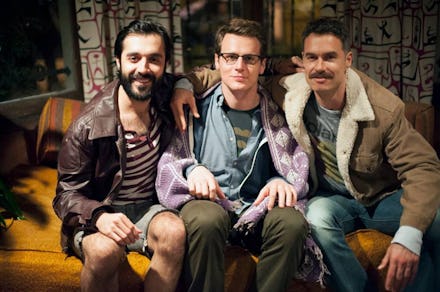'Looking' is Not the Great Gay Show We've Been Waiting For — And That’s a Good Thing

When faced with a show about historically underrepresented minorities, we generally expect two things: 1. That it will complicate our understanding of those people by showing them to be unpredictable and diverse ("Look, not all X's are the same!"); and 2. That it will address — and aggressively challenge — the prevailing negative stereotypes about them.
Looking, a new HBO series about gay men in San Francisco that premiered on Sunday, sometimes meets these expectations, but it just as often flouts them. In its daring — but problematic — depiction of gay men, Looking raises as many important questions about contemporary gay life as Girls has raised about contemporary young womanhood.
A lesser show would have centered on monogamous, desexualized gay couples who couldn't tell Grindr from Words With Friends.
Looking is directed and produced by Andrew Haigh, who previously helmed the highly acclaimed 2011 romantic drama Weekend. The show follows three friends — Patrick (Jonathan Groff, of Glee fame), Agustín (Frankie J. Alvarez) and Dom (Murray Bartlett) — who find themselves both professionally and romantically stunted as leave behind young adulthood.
A show that was interested in flattering gay people and demonstrating that they can be successful, happy and healthy members of the community might have chosen to feature more becoming characters than it does. That show — a lesser show — might have taken the approach adopted by shows like Queer as Folk, Will and Grace, Modern Family or The New Normal, all of which star wealthy, manicured and chipper gay dons who decorate heteronormative society like bright, expensive throw pillows. It would have centered on monogamous, desexualized gay couples who couldn't tell Grindr from Words With Friends.
But Looking isn't looking to advance a thesis about gay people, nor is it concerned with making broad, positive statements about an entire demographic. Its focus is narrow — these are educated, cisgender gay men living in the gay-friendliest city in America — and its project is simple: to tell the story of three people who, in embracing gay life, occasionally get caught up in its dicier aspects.
Patrick, the youngest of these three, is a talented video game designer who's perfectly at home among the Kool-Aid-drinking startup geeks and preteen CEOs of San Francisco. But romantically he's a basket case, bungling nearly every flirtation he attempts with creepy pick-up lines and awkward, conversation-killing remarks.
Jonathan Groff as Patrick. Image credit: HBO via YouTube
Agustín, an artist, represents the reverse: When the show begins, he's just decided to move in with his boyfriend. It should be cause for celebration (yay for gay monogamy!), but he's palpably resistant to the idea of settling down. To make matters worse, he's depressed about his failure to make art.
Dom, the oldest and arguably saddest of the three, is a waiter at posh restaurant with dreams of opening his own eatery. But he spends much of his free time distracting himself with casual sex — usually facilitated through Grindr or a visit to the sauna — and ruminating about his abusive ex-boyfriend.
'Looking' does the radical thing of imbuing its characters with a realism and complexity that's been missing from representations of gay people on television.
Looking's grit and lucidity are best exemplified in its frank portrayal of gay sex. Anti-gay religious and political figures have often called up promiscuity in gay culture as evidence for the moral and physical unhealth of homosexuality. To this day, the concept of casual gay sex is — at least within the wider, heternormative world — inextricably linked with the memory of the AIDS crisis and the continued threat of HIV.
It's understandable, then, that sunnier depictions of gay people, such as those in Modern Family and The New Normal, have shied away from sex. But Looking is rife with cruising and fucking. And though it does make the suggestion that casual gay sex (just like casual straight sex) is emotionally unfulfilling, it's also not afraid to say the truth: that sex feels good, that Grindr is cool, and that cruising remains a fundamental — and fundamentally enticing — ritual of gay life.
Image credit: HBO via YouTube
Liberated from the imperative to represent gay life in a 100% fair and forward-thinking manner, Looking does the radical thing of imbuing its characters with a realism and complexity that's been missing from representations of gay people on television. And the really exciting aspects of Looking are those that don't feel specific to a show about gay people at all. Religion, for instance, has been sneaking its way into characters' conversations. Latin identity, too, seems to be a burgeoning focus of the show.
A press release calls San Francisco the show's "fourth character," and it may be the show's most surprising and dynamic. Given San Fran's outsize place in our cultural and financial landscape, one might expect dreamy shots of the Golden Gate Bridge and party scenes at the Menlo Park mansions of social media zillionaires. Instead, the city is presented as dreary and vaguely threatening. Haigh maintains a remarkable distance from his material. Looking is a show that glamorizes nothing.
Last week Girls began its third season, but it continues to draw the critical and intellectual attention that it did when it first premiered. I have similar hopes for Looking. We should be watching this show closely, keeping tabs on what it shows and doesn't show, and how it embraces its precarious role as an innovative and sorely needed representation of gay life — if it embraces that role at all.